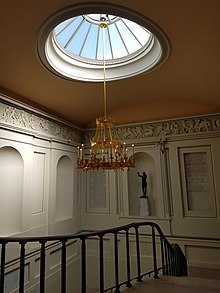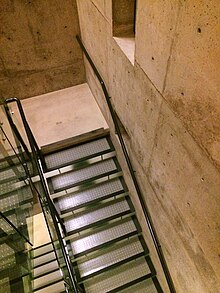
A stairwell or stair room is a room in a building where a stair is located, and is used to connect walkways between floors so that one can move in height. Collectively, a set of stairs and a stairwell is referred to as a staircase or stairway. In buildings with several housing units, a stairway can be a necessary common area for getting to and from apartments.
Staircases provide vertical access to connected floors in a multi-story building, and are a functional part of it. Stairwells are often used to place several stairs one above the other to save vertical space. The entrance to elevators is often located in the stairwell. Sometimes the stairwell goes around the lift shaft, other times it is placed next to it.
An exterior stairway is a stair in a separate structure attached to the rest of the building body, and can either be enclosed or exposed to the elements. Such temporary exposed stairways are sometimes used in conjunction with scaffolding on construction sites, or permanently as an emergency exit.
History

The concept of stairs is believed to be 8000 years old, and are one of the oldest buildings in architectural history. The oldest example of spiral stairs dates back to the 400s BC. Medieval architecture saw experimentation with many different shapes, and the Renaissance even more so with varied designs.
Lighting
Good lighting is important in a staircase so users see where they are going and to prevent falls. There is often a window on the wall to let in daylight. In many cases, indoor stairs are placed far inside the building structure, and it is often not easy to get access to a wall on the outside where it would be natural to have a regular window for letting daylight in. For this reason, it is not unusual to find a skylight or roof windows above a stairwell.
A research article suggests that perceived safety increases when using downwards lighting towards the stairs, while upwards lighting resulted in a substantial decrease of perceived safety.
Handrail
In new stairways, some jurisdictions require handrails to be mounted on both sides.
Emergency exit

Often the stairs in a stairwell are an emergency exit in case of fire, and the stairwell should then be a separate fire compartment separated from the rest of the building via fire doors.
For fire safety it can be advantageous that both the walls, ceiling and the stairs themselves in a stairwell are made of non-combustible materials, and be illuminated with daylight during the day and artificial lighting at darkness.
Storage of objects in shared stairwells is generally prohibited due to the fact that this is often an escape route. This applies to both flammable objects and other objects that may become an obstacle to the rescue work. Many housing cooperatives have general prohibitions against storage in common stairwells.
Utilization
Under stairs there is often a lot of area and volume that is not otherwise used. There are several examples of creative uses, such as wardrobes, home offices, playroom, or general storage such as drawers, cupboards or shelves for storage.
-
 Closet under a staircase
Closet under a staircase
-
 Model of the cupboard under the staircase where the character Harry Potter grew up
Model of the cupboard under the staircase where the character Harry Potter grew up
See also
References
- "Det Norske Akademis ordbok". Retrieved 2024-02-11.
- How not to mess up your loft conversion stairs
- "Det Norske Akademis ordbok". Retrieved 2024-02-11.
- "History of Stairs, Ancient Stairs". www.elevestairs.com. Retrieved 2024-02-14.
- ^ "The History of Stairs: From Fascinating Architecture to Access Barriers | Stannah". Blog USA. 2018-12-18. Retrieved 2024-02-14.
- Thomas, Neil M.; Skervin, Timmion; Foster, Richard J.; O'Brien, Thomas D.; Carpenter, Mark G.; Maganaris, Constantinos N.; Baltzopoulos, Vasilios; Lees, Carolyn; Hollands, Mark A. (2020-04-01). "Optimal lighting levels for stair safety: Influence of lightbulb type and brightness on confidence, dynamic balance and stepping characteristics". Experimental Gerontology. 132: 110839. doi:10.1016/j.exger.2020.110839. ISSN 0531-5565. PMID 31958491. S2CID 210703463.
- Van de Perre, Laurens; Danschutter, Stefan; Janssens, Kim; Hanselaer, Peter; Dujardin, Marc; Smet, Kevin A. G.; Ryckaert, Wouter R. (2019-12-01). "Safety perception of stairs with integrated lighting". Building and Environment. 166: 106389. Bibcode:2019BuEnv.16606389V. doi:10.1016/j.buildenv.2019.106389. ISSN 0360-1323. S2CID 203123801.
- "Byggteknisk forskrift (TEK17) med veiledning, III Bygningsdeler, § 12-14. Trapp" (PDF).
- Ziavras, Valerie (2021-08-06). "Types of Permissible Vertical Openings". National Fire Protection Association. Retrieved 2024-02-14.
- ^ "Ofte stilte spørsmål" (in Norwegian Bokmål). Retrieved 2024-02-11.
- "Ofte stilte spørsmål". Branntips EN. Retrieved 2024-02-14.
- Mushro, Amanda (2023-08-21). "11 Awesome Under-Stairs Storage And Design Ideas To Make The Most Of Your Space". Forbes. Retrieved 2024-02-11.
- "How to turn the awkward space under the stairs into your favourite corner at home". Architectural Digest India. 2021-09-03. Retrieved 2024-02-14.